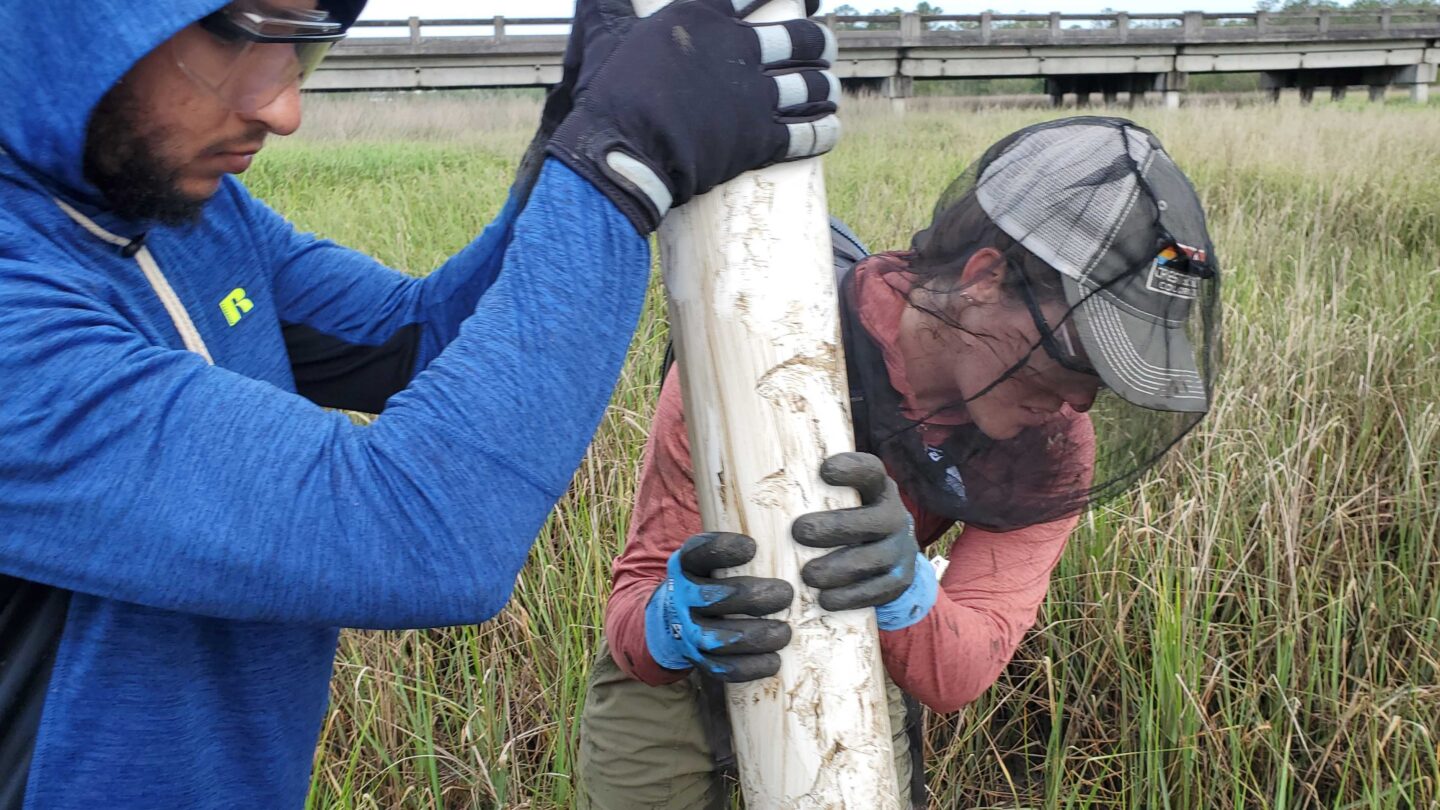This coverage is made possible through a partnership with WABE and Grist, a nonprofit, independent media organization dedicated to telling stories of climate solutions and a just future.
Early one morning in June, sporting bug spray and waterproof shoes, a research team waded out into a marsh about halfway between Savannah and Brunswick, on the edge of Blackbeard Creek. They didn’t have far to walk, but it was tough going. When the thick mud gets hold of something — like a foot — it doesn’t let go easily. Everyone sank in at some point, often past their knees.
The team navigated the deep muck so they could take samples of it with a big piece of PVC pipe. They pushed it into the mud, capped it to create a vacuum seal, then — battling the grip of the mud again — hauled it out again, collecting what’s called a core sample.
Back in the lab, they tested that sample for carbon.
Along with absorbing floodwater from storms, providing habitat for all sorts of birds and critters and myriad other benefits, marshes are great at storing carbon dioxide, keeping it out of the atmosphere.
The team in the marsh were part of a larger, interdisciplinary group of researchers working to find out just how much carbon marshes are storing – and just how much we stand to lose if those marshes are destroyed.
“If we are losing salt marshes, basically, we are losing the storage to sequester carbon,” said researcher Sonny Kim of the University of Georgia.
Sea level rise due to climate change is eroding marshes, and drought from climate change is drying and changing them. The U.S. has already lost more than half its salt marshes, Kim said, so it’s essential to monitor them on a large scale.
The trouble is that collecting core samples in order to measure the actual level of carbon below the surface is a slow, messy, treacherous process that takes a lot of time and money.
“It is hard to take even one core out,” Kim said. “So it was our idea that, why don’t we just use remote sensing or other existing, low-cost sensors to measure soil organic carbon so that we can continuously monitor without actually taking soil out from the salt marshes?”
Along with core samples, the team collected other readings from a variety of sensors measuring properties like color and light spectrum, which they can use to predict the carbon below. They can check the predictions against the actual carbon level in the cores.
“We’re going to be comparing it,” said Researcher Lori Sutter of the University of North Carolina Wilmington. “What we’re trying to find is the sensor that gets us closest to actual, that we actually go back to the lab and measure.”
Then, using machine learning, they hope to teach computers to take those measurements from satellite or drone imagery.
This is why the researchers involved come from a wide range of backgrounds. Sutter is a marine biologist with extensive marsh experience, while Kim is an engineer. They’re also working with computer scientists.
“These cannot be done by one single expertise, or college of engineering or something like that,” Kim said. “We have to work together as an interdisciplinary group. And that way, we can actually look at all the different aspects.”
Scientists have succeeded at predicting the carbon level at the marsh surface using this kind of remote sensing, but this group is trying to extend that work below the surface to get a fuller picture of the carbon stored in marshes.
It’s important to quantify this because it’s part of a vicious cycle, Kim said. Losing marshes means losing carbon storage, which, in turn, worsens climate change and the impacts of droughts and rising seas that further harm marshes.
Measuring carbon in marshes on a large scale could also have implications beyond the academic, according to Kim. It could be a way to quantify the impact of a natural disaster on marshland, for instance, or measure the damage done by a construction project — and how to restore a damaged marsh.
“We are looking at the soil organic carbon storage, but in the end, we would like to provide some of the more practical usage, how those [marshes] could be rehabilitated,” he said.








